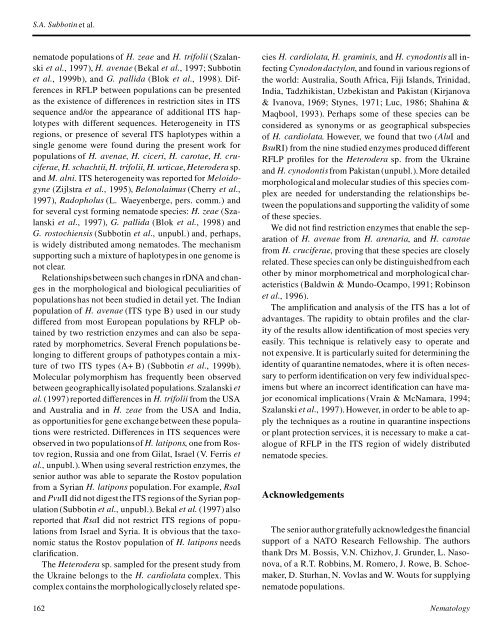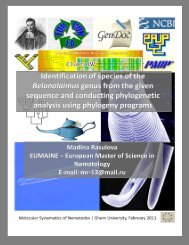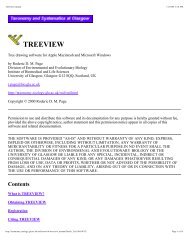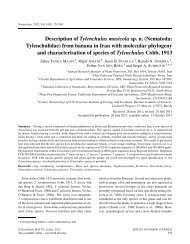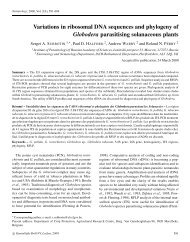Identification of cyst forming nematodes of the genus Heterodera ...
Identification of cyst forming nematodes of the genus Heterodera ...
Identification of cyst forming nematodes of the genus Heterodera ...
You also want an ePaper? Increase the reach of your titles
YUMPU automatically turns print PDFs into web optimized ePapers that Google loves.
S.A. Subbotin et al.<br />
nematode populations <strong>of</strong> H. zeae and H. trifolii (Szalanski<br />
et al., 1997), H. avenae (Bekal et al., 1997; Subbotin<br />
et al., 1999b), and G. pallida (Blok et al., 1998). Differences<br />
in RFLP between populations can be presented<br />
as <strong>the</strong> existence <strong>of</strong> differences in restriction sites in ITS<br />
sequence and/or <strong>the</strong> appearance <strong>of</strong> additional ITS haplotypes<br />
with different sequences. Heterogeneity in ITS<br />
regions, or presence <strong>of</strong> several ITS haplotypes within a<br />
single genome were found during <strong>the</strong> present work for<br />
populations <strong>of</strong> H. avenae, H. ciceri, H. carotae, H. cruciferae,<br />
H. schachtii, H. trifolii, H. urticae, <strong>Heterodera</strong> sp.<br />
and M. alni. ITS heterogeneity was reported for Meloidogyne<br />
(Zijlstra et al., 1995), Belonolaimus (Cherry et al.,<br />
1997), Radopholus (L. Waeyenberge, pers. comm.) and<br />
for several <strong>cyst</strong> <strong>forming</strong> nematode species: H. zeae (Szalanski<br />
et al., 1997), G. pallida (Blok et al., 1998) and<br />
G. rostochiensis (Subbotin et al., unpubl.) and, perhaps,<br />
is widely distributed among <strong>nematodes</strong>. The mechanism<br />
supporting such a mixture <strong>of</strong> haplotypes in one genome is<br />
not clear.<br />
Relationshipsbetween such changesin rDNA and changes<br />
in <strong>the</strong> morphological and biological peculiarities <strong>of</strong><br />
populations has not been studied in detail yet. The Indian<br />
population <strong>of</strong> H. avenae (ITS type B) used in our study<br />
differed from most European populations by RFLP obtained<br />
by two restriction enzymes and can also be separated<br />
by morphometrics. Several French populations belonging<br />
to different groups <strong>of</strong> pathotypes contain a mixture<br />
<strong>of</strong> two ITS types (A+ B) (Subbotin et al., 1999b).<br />
Molecular polymorphism has frequently been observed<br />
between geographicallyisolated populations.Szalanski et<br />
al. (1997) reported differences in H. trifolii from <strong>the</strong> USA<br />
and Australia and in H. zeae from <strong>the</strong> USA and India,<br />
as opportunitiesfor gene exchange between <strong>the</strong>se populations<br />
were restricted. Differences in ITS sequences were<br />
observed in two populations<strong>of</strong> H. latipons, one from Rostov<br />
region, Russia and one from Gilat, Israel (V. Ferris et<br />
al., unpubl.). When using several restriction enzymes, <strong>the</strong><br />
senior author was able to separate <strong>the</strong> Rostov population<br />
from a Syrian H. latipons population. For example, RsaI<br />
and PvuII did not digest <strong>the</strong> ITS regions <strong>of</strong> <strong>the</strong> Syrian population<br />
(Subbotin et al., unpubl.). Bekal et al. (1997) also<br />
reported that RsaI did not restrict ITS regions <strong>of</strong> populations<br />
from Israel and Syria. It is obvious that <strong>the</strong> taxonomic<br />
status <strong>the</strong> Rostov population <strong>of</strong> H. latipons needs<br />
clari cation.<br />
The <strong>Heterodera</strong> sp. sampled for <strong>the</strong> present study from<br />
<strong>the</strong> Ukraine belongs to <strong>the</strong> H. cardiolata complex. This<br />
complex contains <strong>the</strong> morphologicallyclosely related spe-<br />
cies H. cardiolata, H. graminis, and H. cynodontis all infecting<br />
Cynodondactylon, and found in various regions <strong>of</strong><br />
<strong>the</strong> world: Australia, South Africa, Fiji Islands, Trinidad,<br />
India, Tadzhikistan, Uzbekistan and Pakistan (Kirjanova<br />
& Ivanova, 1969; Stynes, 1971; Luc, 1986; Shahina &<br />
Maqbool, 1993). Perhaps some <strong>of</strong> <strong>the</strong>se species can be<br />
considered as synonyms or as geographical subspecies<br />
<strong>of</strong> H. cardiolata. However, we found that two (AluI and<br />
BsuRI) from <strong>the</strong> nine studied enzymes produced different<br />
RFLP pro les for <strong>the</strong> <strong>Heterodera</strong> sp. from <strong>the</strong> Ukraine<br />
and H. cynodontis from Pakistan (unpubl.). More detailed<br />
morphologicaland molecular studies <strong>of</strong> this species complex<br />
are needed for understanding <strong>the</strong> relationships between<br />
<strong>the</strong> populationsand supporting <strong>the</strong> validity <strong>of</strong> some<br />
<strong>of</strong> <strong>the</strong>se species.<br />
We did not nd restriction enzymes that enable <strong>the</strong> separation<br />
<strong>of</strong> H. avenae from H. arenaria, and H. carotae<br />
from H. cruciferae, proving that <strong>the</strong>se species are closely<br />
related. These species can only be distinguishedfrom each<br />
o<strong>the</strong>r by minor morphometrical and morphological characteristics<br />
(Baldwin & Mundo-Ocampo, 1991; Robinson<br />
et al., 1996).<br />
The ampli cation and analysis <strong>of</strong> <strong>the</strong> ITS has a lot <strong>of</strong><br />
advantages. The rapidity to obtain pro les and <strong>the</strong> clarity<br />
<strong>of</strong> <strong>the</strong> results allow identi cation <strong>of</strong> most species very<br />
easily. This technique is relatively easy to operate and<br />
not expensive. It is particularly suited for determining <strong>the</strong><br />
identity <strong>of</strong> quarantine <strong>nematodes</strong>, where it is <strong>of</strong>ten necessary<br />
to perform identi cation on very few individualspecimens<br />
but where an incorrect identi cation can have major<br />
economical implications (Vrain & McNamara, 1994;<br />
Szalanski et al., 1997). However, in order to be able to apply<br />
<strong>the</strong> techniques as a routine in quarantine inspections<br />
or plant protection services, it is necessary to make a catalogue<br />
<strong>of</strong> RFLP in <strong>the</strong> ITS region <strong>of</strong> widely distributed<br />
nematode species.<br />
Acknowledgements<br />
The senior author gratefully acknowledges<strong>the</strong> nancial<br />
support <strong>of</strong> a NATO Research Fellowship. The authors<br />
thank Drs M. Bossis, V.N. Chizhov, J. Grunder, L. Nasonova,<br />
<strong>of</strong> a R.T. Robbins, M. Romero, J. Rowe, B. Schoemaker,<br />
D. Sturhan, N. Vovlas and W. Wouts for supplying<br />
nematode populations.<br />
162 Nematology


